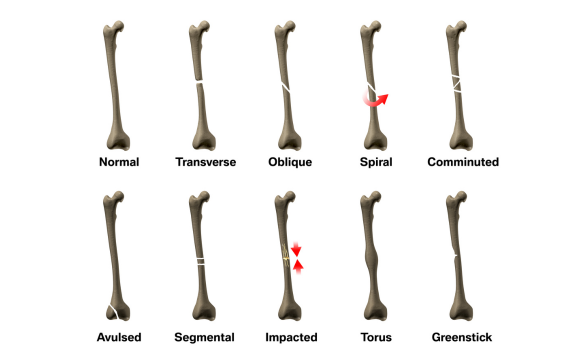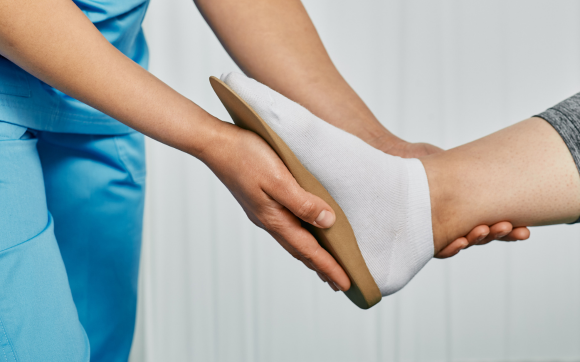Orthopedics
Recently injured or that nagging pain that you thought would go away… but didn’t?
We are well versed in most orthopedic injuries including by not limited to:
Potential Injuries

Stress fractures
A stress fracture is a small crack in a bone that usually occurs in weight-bearing bones after repetitive stress or overuse. They occur more commonly when a new training regime is started. Initially, rest is important to aid in recovery. Still, Physical Therapy can help by strengthening the muscles around the injury, preparing the body to return to activity, and facilitating the desired activities without injury recurrence.

Shin splints
A shin splint is characterized by pain along your shin bone, or tibia, and usually occurs after an increase in training or change in training program. It is usually caused by repetitive stress. Catching a shin splint early and stopping its progression will help you recover faster and return to your activities sooner. Physical Therapy can help by assessing any muscle weakness or imbalance, your walking, running, and movement patterns, and then addressing any altered patterns. A shin splint can become a stress fracture or other injuries if not addressed.

Posture
Posture is how you hold your body in space and in relation to itself. When we align our bodies with good posture, our muscles are at their optimal position for strength, endurance, and daily activities. With fatigue, pain, stress, or injury, we often slouch forward during sitting and standing. This can stretch out muscles that are supposed to be tight and strong and cause other muscles to overtighten. This can lead to pain, decreased balance, and changes in how our bones and bodies move. Your PT will examine your muscle strength and endurance, your body alignment, and how you move within your environment. Your PT may also complete an ergonomic assessment of your work or school environment to help promote better posture during activities.

Radiculopathy
Radiculopathy is when pain or numbness travels down your arm or leg. A compression or pinching of the nerve usually causes it. This can occur at the spine (neck, mid back, or lower back), near a joint, or under a tight muscle. Physical Therapy can help by completing a comprehensive evaluation, finding the root cause(s) of the compression, and then addressing it with stretching, strengthening, and stabilization.

Chronic pain
Chronic pain may have many causes but is defined as having pain that lasts for more than three months. After three months, the brain and body communicate differently and affect more parts of the body. Your movement patterns may become more altered, and you may have more compensations in your daily life. This, in turn, may contribute to your pain. Physical Therapy will include a thorough evaluation of your area of pain and surrounding areas and start to address these areas through stretching, exercises to strengthen, activation of muscles that are not working correctly, deactivation of muscles that are overworking, and manual techniques to improve mobility and alignment and decrease pain. Due to your body changing the way it reacts to pain, chronic pain often has a psychological component as well, and your PT may recommend following up with your MD for this aspect and/or may help you with pain neuroscience education.

Labral injures
The labrum is a cartilage ring that helps joints move better with decreased injuries and improved stability. Two examples of joints with a labrum is your shoulder and your hip. Your labrum can be injured with overstretching of a joint or repetitive use. If your labrum is torn, your MD may prescribe Physical Therapy, surgery or both. Physical Therapy includes a thorough examination of your injured joint and surrounding areas and then addresses any limitations through specific strengthening, stretching, stabilization and on promotion of daily activities. Physical therapy can help to decrease your pain, promote early movement and mobility and facilitate your return to household, work, school and/or sports activities.

Tendinosis
Tendinosis, more commonly known as tendinitis, is an injury to the area where a muscle attaches to a bone or a tendon. It is often caused by repetitive overuse, poor posture, or repetitive stresses. It commonly affects shoulders, elbows, wrists, knees, and ankles but can affect any muscle tendon. Physical therapy can help with tendon injuries by assisting with resting the joint and then progressively increasing the amount of exercises and activities to tolerance. Your PT will complete a thorough examination and then recommend a treatment plan to help you accomplish your goals. Your PT may use manual techniques to help facilitate tissue healing and promote recovery faster.

Screening for injuries
Not sure if you have an injury or just a nagging pain? Your PT can also complete a 5-10 min screen in which they look at your motion, talk to you about your injury, and then recommend MD follow-up, PT, and/or rest. For a screen, your PT will do a quick assessment rather than a thorough evaluation but may recommend a full PT evaluation depending on the screen results.

Walking/gait analysis
Gait is how you are walking. A PT can look at how you are walking, from how you swing your arms to how your feet contact and then push off from the floor. How you walk can change how the forces are transmitting up your feet, ankles, knees, hip, lower back, mid-back, and neck. By altering the different parts of how you are walking or your gait pattern, you can walk more efficiently and with less pain and stresses.

Movement pattern analysis
Movement pattern analysis is an important component of Physical Therapy; this allows your PT to set up an appropriate treatment program for you. Movement analysis is completed by observing how you are moving, seeing which muscles are overworking, which are underworking, which are loose, and which are tight. Your PT will then use this analysis to help you to get better faster.

Postoperative PT
Your MD may order physical therapy after a surgery or procedure. Your PT will work with your MD to see if you have any post-operative restrictions or protocols to follow to allow the surgical site to heal. Your PT will thoroughly assess your muscle’s range of motion, strength, flexibility, and stability, discuss their findings and your goals, and then set up a treatment plan for you. Your PT can help you move and regain strength and your ability to complete daily activities and recreational activities within your limits and your post-surgical limitations and restrictions.

